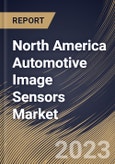Rearview cameras are now a standard feature in many vehicles, offering drivers a visual aid when reversing. These cameras are invaluable for avoiding collisions with obstacles or pedestrians in the blind spots behind the vehicle. Surround-view or bird's-eye view systems use multiple cameras to provide a composite, top-down view of the vehicle's surroundings. This aids in parking, low-speed maneuvering, and off-road driving, contributing to safer and more convenient driving experiences. Infrared (IR) image sensors are used in automotive night vision systems to enhance visibility during low-light and nighttime driving. These sensors can detect and display the presence of pedestrians, animals, and other objects beyond the range of conventional headlights.
Additionally, image sensors play a vital role in pedestrian detection systems, which are integral to preventing accidents involving pedestrians. These systems can identify pedestrians in or near the vehicle's path and trigger alerts or automatic braking to avoid collisions. Image sensors are used in traffic sign recognition systems to detect and interpret road signs, such as speed limits and stop signs. This information can be displayed to the driver, assisting with compliance with traffic regulations. Gesture control systems utilize image sensors to track hand movements and gestures the driver or passengers make. This technology can be employed for various in-cabin controls, enhancing the user experience and convenience. Image sensors are also used to monitor vehicle occupants. This application aids in ensuring seatbelt usage and detecting drowsiness or distraction, contributing to overall passenger safety.
Moreover, vehicle sales are also increasing in Canada. A growing economy often increases consumer confidence and disposable income, boosting vehicle sales. Canada's economic stability and prosperity can be a driving factor in the sale of vehicles. As the population of Canada grows, there is a natural increase in the demand for personal transportation, including cars. Urbanization trends also contribute to this demand. The automotive sector is an essential contributor to Canada's GDP. According to the data by Statistics Canada, 147,401 motor vehicles were sold in Canada in July 2021. Therefore, the increase in motor vehicles demand in the North America region will boost the demand for automotive image sensors in the region.
The US market dominated the North America Automotive Image Sensors Market, By Country in 2022, and would continue to be a dominant market till 2030; thereby, achieving a market value of $1,033.5 million by 2030. The Canada market is exhibiting a CAGR of 13.4% during (2023 - 2030). Additionally, The Mexico market would experience a CAGR of 12.4% during (2023 - 2030).
Based on Technology, the market is segmented into CMOS, and CCD. Based on Vehicle Type, the market is segmented into Passenger Vehicles, and Commercial Vehicles. Based on countries, the market is segmented into U.S., Mexico, Canada, and Rest of North America.
The market research report covers the analysis of key stake holders of the market. Key companies profiled in the report include Samsung Electronics Co., Ltd. (Samsung Group), Continental AG, Infineon Technologies AG, Denso Corporation, OmniVision Technologies, Inc., Sharp Corporation (Hon Hai Precision Industry Co., Ltd), NXP Semiconductors N.V., Gentex Corporation, Canon, Inc., and Teledyne Technologies, Inc.
Scope of the Study
Market Segments Covered in the Report:
By Technology (Volume, Thousand Units, USD Million, 2019-2030)- CMOS
- CCD
- Passenger Vehicles
- Commercial Vehicles
- US
- Canada
- Mexico
- Rest of North America
Key Market Players
List of Companies Profiled in the Report:
- Samsung Electronics Co., Ltd. (Samsung Group)
- Continental AG
- Infineon Technologies AG
- Denso Corporation
- OmniVision Technologies, Inc.
- Sharp Corporation (Hon Hai Precision Industry Co., Ltd)
- NXP Semiconductors N.V.
- Gentex Corporation
- Canon, Inc.
- Teledyne Technologies, Inc.
Unique Offerings
- Exhaustive coverage
- The highest number of Market tables and figures
- Subscription-based model available
- Guaranteed best price
- Assured post sales research support with 10% customization free
Table of Contents
Companies Mentioned
- Samsung Electronics Co., Ltd. (Samsung Group)
- Continental AG
- Infineon Technologies AG
- Denso Corporation
- OmniVision Technologies, Inc.
- Sharp Corporation (Hon Hai Precision Industry Co., Ltd)
- NXP Semiconductors N.V.
- Gentex Corporation
- Canon, Inc.
- Teledyne Technologies, Inc.








